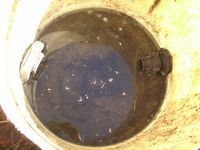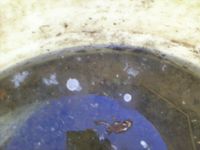This page addresses the outstanding issues involved the CCAT's greywater marsh.
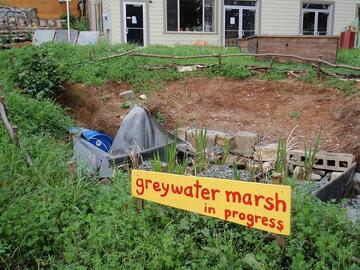
CCAT Background[edit | edit source]
The Campus Center for Appropriate Technology (CCAT), located on the south side of the Cal Poly Humboldt campus in Arcata, California, is designed as a laboratory for sustainability.[2] CCAT is a student run non-profit organization that acquired a house in 1978 and became an official Associated Students program in 1980.[2] The building was moved and remodeled in 2004.[2] After the building was completed in 2007, the student directors were able to move into the house and progress in creating a model of a sustainable home..[2] For the past 31 years, CCAT has been dedicated to demonstrating appropriate technology to HSU students and the surrounding community.[2] CCAT has been successful in spreading its information by connecting with over fifteen HSU courses per year and providing workshops, community projects, lectures, guest speakers, potlucks, volunteer workdays and much more.[2] One course that CCAT works with is ENGR115 Introduction to Environmental Engineering and Science.
Greywater - Defined[edit | edit source]
Greywater consists of all household effluent wastewater from bathtubs, showers, bathroom sinks and the washing of clothes not contaminated with human fecal matter. According to California's Health and Safety Code Section 17922.12, greywater means:
"untreated wastewater that has not been contaminated by any toilet discharge, has not been affected by infectious, contaminated, or unhealthy bodily wastes, and does not present a threat from contamination by unhealthful processing, manufacturing, or operating wastes. Greywater includes but is not limited to wastewater from bathtubs, showers, bathroom washbasins, clothes washing machines, and laundry tubs, but does not include wastewater from kitchen sinks or dishwashers."[3]
CCAT's Greywater Marsh[edit | edit source]
The current greywater marsh at CCAT, a sub-surface greywater treatment system[4] renovated in the spring of 2009, contains five main parts: surge tank, FOG catcher, marsh, testing tank and irrigation, as shown in Figure 3.
-
Figure 2 - The current status of the CCAT greywater marsh. Photo by Ben Stern
-
Figure 3 - Drawing of greywater system and its five parts.[1]
Surge Tank[edit | edit source]
The outlet of the house's plumbing discharges greywater into a surge tank, as shown Figure 4, which prevents back flow of greywater into the house. The inlet to the surge tank has a shutoff valve, allowing the greywater to be diverted to the city sewer if a problem occurs in the greywater system. The surge tank is equipped with a filter, as shown on top of the surge tank in Figure 4. The filter is designed to remove larger solids while allowing greywater to be gravity fed to the second part of the treatment process, the settling tank.
-
Figure 4 - Top view of surge tank connected to the house plumbing. The filtering mechanism has been pulled out and placed on top. Photo by Ben Stern
FOG Catcher/Settling Tank[edit | edit source]
The settling tank, or fat oil and grease (FOG) catcher, as shown in Figure 5, contains a baffle that traps FOG, preventing FOG from entering the marsh. The settling tank slows the flow rate of the greywater to allow the settling of solids and sediment into the bottom of the tank before flowing into the marsh.
-
Figure 5 - Top view of the current FOG catcher. Photo by Ben Stern
Marsh[edit | edit source]
The marsh allows the greywater to flow through gravel that contains five alternating baffles, as shown in Figure 6. The marsh is used for secondary treatment, in which plant roots encourage microbial growth that break down organic matter reducing the Biochemical Oxygen Demand (BOD). The gravel traps the remaining particulates that passed through the settling tank, which reduces the amount of Total Suspended Solids (TSS). The greywater is then funneled into the testing tank.
-
Figure 6 - Side view drawing of the baffles in the greywater marsh.[1]
Testing Tank[edit | edit source]
The greywater testing tank allows access to the treated greywater for water quality testing. It also contains a pipe that can be adjusted to change the height of the greywater in the marsh. Altering greywater height is necessary for healthy root growth in the marsh plants.
Irrigation System[edit | edit source]
The greywater then passes through the perforated pipe of the gravity fed irrigation system, as shown in Figure 7, for the CCAT landscaping. The perforated pipe allows for even distribution of the greywater, preventing any pools that could settle and cause bacterial growth. The plants receiving the greywater are water loving and alkaline tolerant, including an apple tree, a current bush, an evergreen huckleberry, two rose bushes, a coffeeberry, and monkey flowers. The plants are allowed for human consumption because the fruits do not come into direct contact with the greywater and the high abundance of organic matter (mulch and compost) in the soil consumes any leftover bacteria from the greywater.[5]More detailed information and a diagram of the whole system layout can be found on the CCAT greywatermarsh (current)]][1] webpage on Appropedia.
-
Figure - 7: General layout of the underground gravity fed irrigation system, which terminates the greywater system.[1]
Greywater Marsh Problems[edit | edit source]
There are several problems with the design and efficiency of the current CCAT greywater marsh system that was implemented in the spring of 2009. The problems have included filtrating of solids, FOG collection, standing water, and maintenance.
Filtering of Solids[edit | edit source]
The CCAT greywater system is unique because it includes greywater from the kitchen sink, which has a high concentration of particulate matter due to food scraps. The high concentration of particulate matter increases the BOD.[6]Under normal circumstance the inclusion of the kitchen sink would not be acceptable under California law, but CCAT is on a university campus and their marsh is considered experimental. There is currently only one filter, as shown in Figure 8, made from a small trash receptacle equipped with a small one millimeter metal screen. The filter attaches inside the surge tank to the outlet pipe. The filter has oxidized creating the build-up of rust, which has decreased the diameter of the holes on the filter. The rust build-up lets small solids and dried FOG clog the bottom part of the filter. The metal screen has also broken away from the plastic trash receptacle as shown in Figure 8. The broken filter allows large amounts of particulates to pass through the filter into the settling/FOG tank. The particulates pass rapidly through the settling/FOG tank into the marsh because the baffle in the settling tank does not decrease the flow of greywater enough to allow the particulates to settle out. These particulates build up in the marsh and eventually block the flow of greywater through the marsh.[4]
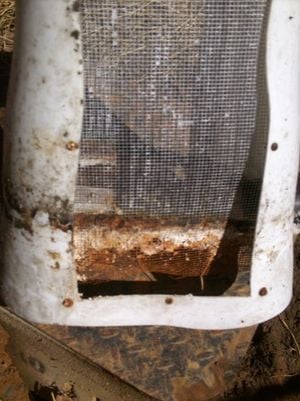
FOG Collection[edit | edit source]
The FOG catcher in the CCAT greywater system is unable to function correctly due to the increased amount of FOG coming from the kitchen sink. The corroded and clogged filter in the surge tank is collecting most of the FOG, preventing FOG from flowing into the FOG catcher. Also the baffle in the FOG catcher, as shown in Figure 9, is unable to slow the flow of the greywater enough for the remaining FOG and particulates to settle and separate. The FOG coats the gravel in the marsh and prevents microbial activity from cleaning the greywater.
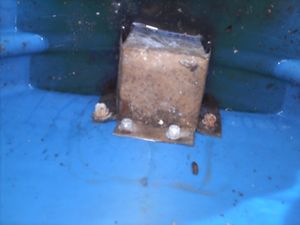
Standing Water[edit | edit source]
The surge tank incorrectly acts as a settling/storage tank of the greywater, as shown in Figure 10. Standing water occurs because the bottom of the surge tank is lower than the outlet pipe, which does not allow all the water to exit through the gravity fed system. Also under CCAT's concrete driveway there is an upward bend in the outlet pipe leading to the settling/FOG tank. Without a constant and forceful flow of greywater through the system, water gets trapped in the surge tank and particulates settle and bacteria begins to grow, as shown in Figure 11. Greywater is considered blackwater (not reusable without intensive treatment) after twenty four hours of being stored. This consideration is due to high concentrations of particulate matter and FOG that increase the growth of harmful bacteria.[7] The potential risk of turning into blackwater makes standing water an issue with CCAT's greywater system.[8]
-
Figure 10 - This picture illustrates the presence of standing water found in the surge tank. Photo by Ben Stern
-
Figure 11 - Bacterial growth, white clumps, in the surge tank due to standing water, 72 hours after marsh was closed. Photo by Ben Stern
Hard to Clean[edit | edit source]
CCAT's greywater system is difficult and intensive to clean. Since the greywater system was designed to be gravity fed, much of the system is located at or below the surface of the ground. The location of the greywater system at or below ground makes the maintenance of the greywater system difficult. This YouTube video shows the detailed process of CCAT's greywater marsh maintenance. Cleaning the tanks of the greywater system is not a pleasant job, but is necessary in order to have an efficient and operational system. According to the YouTube video the surge tank and FOG catcher and their filters need to be cleaned twice a month. However, due to the standing water, corroded filters and the use of sink water in the CCAT system, the tanks should be cleaned near twice a week. The height of the pipe in the collection tank should also be adjusted about every three months to allow the whole system to drain and be cleaned.
Current Improvement Efforts[edit | edit source]
Currently two groups in Engineering 215 - Intro to Design at Cal Poly Humboldt are in the process of designing solutions to the issues of removing particulate matter from the kitchen sink and improving the FOG catcher.
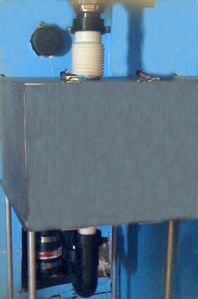
Kitchen effluent particulate filter[edit | edit source]
Team ECO-PLUMBERS[9] which includes William Brown, Charles Flower III, and Zack Chandler, are in the process of designing a filtration system, The Pizza Box as shown in Figure 12, that will fit under the kitchen sink.[9]The filtration system will be composed of two filters of different sizes in a compact box.
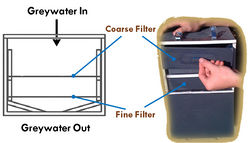
- First: The kitchen sink water will flow through a plastic PVC box with a hinged, rubber sealed, water tight PVC door. Inside the box will be a filter made of 1/4 inch plastic with 3/16 inch holes drilled 3/4 of an inch apart. This filter will remove all of the large food particles that would quickly clog a finer screen.[9]
- Second: The greywater will then pass through a second filter which is very similar to the first but with a finer stainless steel screen, donated by the Tofu Shop in Arcata. This filter is located directly below the larger filter, as shown in Figure 13.[9]
Greywater FOG Collection and Maintenance[edit | edit source]
Currently a group in ENGR 215, VuTastic, consisting of Vu Tran, Tim Kukuk, Aaron Perez are developing reasonable solutions to the problems created by the FOG catcher.[10] Their design, Switch and Swap, involves adding cement to the bottom of the surge tank to match the level of the outlet pipe, as shown in Figure 14.[10] The added cement will help decrease the standing water in the surge tank and allow the FOG to travel to a new FOG catcher, as shown in Figure 14.[10] They have purchased a new 35 gallon plastic barrel to replace the current FOG catcher.[10] This new barrel will be slanted slightly downhill and will consist of a baffle to trap the FOG at the surface of the flowing greywater.[10] The greywater will then flow under the baffle into the marsh as the system is designed.[10]

Recommendations[edit | edit source]
Raising the Surge Tank[edit | edit source]
Although team VuTastic's design includes adding concrete to the bottom of the surge tank, there is still the problem of the upward curve in the outlet pipe under the driveway. The upward curve in the pipe leading to the FOG catcher, only allows for water higher than the the curve level to flow through it resulting in the presence of standing water. Solutions to this problem are:
- Raising the bottom of the surge tank and the outlet pipe to be slightly higher than the curve in the pipe
- Adding a pump in the surge tank
- Create a siphon (suction) system
Pressure Washing[edit | edit source]
Any greywater system is inevitably unsanitary because it is dealing with wastewater. Cleaning the system would be made easier if cleaned more frequently. One alternative to clean the system with minimal labor would be to regularly flush the system with clean water. The cleaning is also made difficult with the inadequate access to the system parts. This issue is difficult to address due to the design of the gravity fed system, which requires the tanks to be located below ground level.
References[edit | edit source]
- ↑ 1.0 1.1 1.2 1.3 1.4 Payne, L., Medina, S., & Ebright, T. CCAT greywater marsh (current) - Appropedia: The sustainability wiki. Appropedia. Accessed online November 15, 2009, from https://www.appropedia.org/CCAT greywater marsh (current).
- ↑ 2.0 2.1 2.2 2.3 2.4 2.5 Campus Center for Appropriate Technology. Cal Poly Humboldt. Accessed online November 15, 2009, from http://web.archive.org/web/20100629034647/http://www.humboldt.edu:80/~ccat
- ↑ California Graywater Code. Oasis Design: Grey Water Books, Ecological Design Information & Consulting. Accessed online November 25, 2009, from http://www.oasisdesign.net/greywater/law/california/currentcode/#code
- ↑ 4.0 4.1 Watkins, C., & Graffman, L. Subsurface flow constructed wetland for greywater - Appropedia: The sustainability wiki. Appropedia. Accessed online November 15, 2009, from https://www.appropedia.org/Subsurface_flow_constructed_wetland_for_greywater
- ↑ Barker, Allen V., & English Jean E. Department of Plant and Soil Sciences, University of Massachusetts, Amherst. Recycling Gray Water for Home Gardens. Accessed online December 9, 2009, from http://www.umassgreeninfo.org/fact_sheets/plant_culture/gray_water_for_gardens.html
- ↑ Davis, Mackenzie, and Susan Masten. Principles of Environmental Engineering and Science. McGraw Hill: New York, NY 2004.
- ↑ Ludwig, A. Common Greywater Mistakes and Preferred Practices. Oasis Design: Grey Water Books, Ecological Design Information & Consulting. Accessed online December 6, 2009, from http://www.oasisdesign.net/greywater/misinfo/index.htm
- ↑ Grey Water. Water Wise Systems. Accessed online November 25, 2009, from WaterWise Systems http://web.archive.org/web/20151024141127/http://www.waterwisesystems.com/grey-water
- ↑ 9.0 9.1 9.2 9.3 9.4 Brown, W., Chandler, Z., & Flower, C. CCAT Kitchen effluent greywater filter - Appropedia: The sustainability wiki. Appropedia. Accessed online November 15, 2009, from https://www.appropedia.org/CCAT_Kitchen_effluent_particulate_filter
- ↑ 10.0 10.1 10.2 10.3 10.4 10.5 10.6 Kukuk, T., Perez, A., & Tran, V. CCAT greywater grease trap - Appropedia: The sustainability wiki. Appropedia. Accessed online November 15, 2009, from https://www.appropedia.org/Grease_trap#next_steps
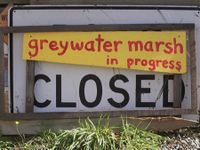
![Figure 3 - Drawing of greywater system and its five parts.[1]](/w/images/thumb/6/68/Ccat_grywtr_sys_lyout.jpg/200px-Ccat_grywtr_sys_lyout.jpg)
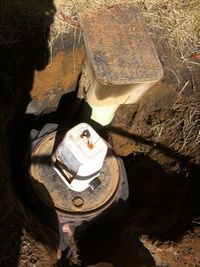
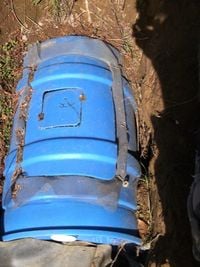
![Figure 6 - Side view drawing of the baffles in the greywater marsh.[1]](/w/images/thumb/9/9c/Ccat_grywtr_sys_section.jpg/200px-Ccat_grywtr_sys_section.jpg)
![Figure - 7: General layout of the underground gravity fed irrigation system, which terminates the greywater system.[1]](/w/images/thumb/c/cd/Ccat_grywtr_irrig_lyout.jpg/200px-Ccat_grywtr_irrig_lyout.jpg)
